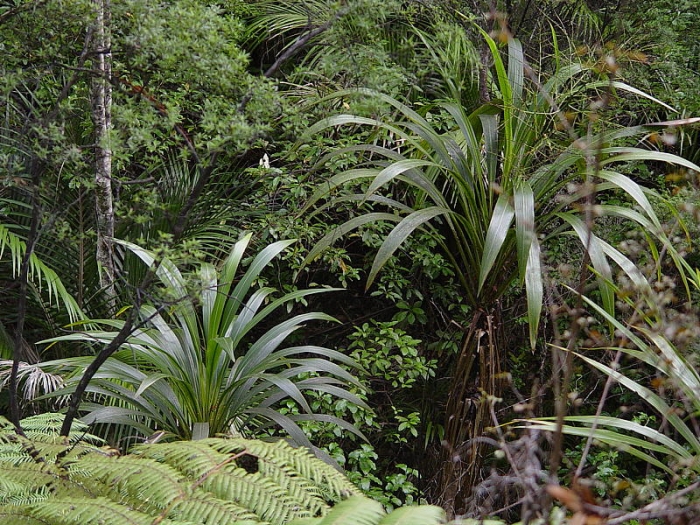Forest Cabbage Tree
(Cordyline banksii)
Forest Cabbage Tree (Cordyline banksii)
/
/

tanetahi
CC BY 2.0
Image By:
tanetahi
Recorded By:
Copyright:
CC BY 2.0
Copyright Notice:
Photo by: tanetahi | License Type: CC BY 2.0 | License URL: https://creativecommons.org/licenses/by/2.0 | Uploader: Flickr upload bot | Publisher: Wikimedia Commons | Title: Cordyline_banksii_near_Tapotupotu,_Aupouri_Peninsula.jpg | Notes: Transferred from Flickr by [[User:Tim1357]] using flickr2commons |





















































Estimated Native Range
Summary
Cordyline banksii, commonly known as Forest Cabbage Tree, is an evergreen tree endemic to the open woodlands, forest margins, and scrubland of New Zealand. It is a sparingly-branched tree that can reach up to 4 meters (13 ft) in height. The Forest Cabbage Tree has narrow, long, and arching leaves, which can add a distinctive, tropical appearance to gardens. Its flowers are white, pleasantly perfumed, and typically bloom in large, dense panicles during the spring and early summer. The globe-shaped fruit, which can be white, bluish-white, or blue, are small but can add ornamental value to the plant when present.
Cordyline banksii is valued for its ease of maintenance and its ability to adapt to a variety of soil conditions, including steep slopes and poorly drained sites. It is also appreciated for its striking foliage, which can range from green to purple, depending on the cultivar. Common uses in cultivation include urban planting, border planting, and as a focal point in subtropical themed gardens. It is hardy in USDA zones 10a and 11, preferring full sun but can tolerate part shade. While it can survive with low to medium water requirements, it thrives in soils with medium to fast drainage. Popular cultivars include ’Electric Pink’ with vibrant pink and burgundy leaves and ’Electric Star’ with green and yellow striped leaves. Potential problems include root rot in overly wet soils and damage from frosts in cooler climates. It is not known to be invasive outside its native range.CC BY-SA 4.0
Cordyline banksii is valued for its ease of maintenance and its ability to adapt to a variety of soil conditions, including steep slopes and poorly drained sites. It is also appreciated for its striking foliage, which can range from green to purple, depending on the cultivar. Common uses in cultivation include urban planting, border planting, and as a focal point in subtropical themed gardens. It is hardy in USDA zones 10a and 11, preferring full sun but can tolerate part shade. While it can survive with low to medium water requirements, it thrives in soils with medium to fast drainage. Popular cultivars include ’Electric Pink’ with vibrant pink and burgundy leaves and ’Electric Star’ with green and yellow striped leaves. Potential problems include root rot in overly wet soils and damage from frosts in cooler climates. It is not known to be invasive outside its native range.CC BY-SA 4.0
Plant Description
- Plant Type: Tree
- Height: 6-10 feet
- Width: 3-4 feet
- Growth Rate: Moderate
- Flower Color: White
- Flowering Season: Summer
- Leaf Retention: Evergreen
Growth Requirements
- Sun: Full Sun
- Water: Medium
- Drainage: Medium, Fast
Common Uses
Bee Garden, Bird Garden, Border Plant, Butterfly Garden, Drought Tolerant, Fragrant, Low Maintenance, Potted Plant
Natural Habitat
Open woodlands, forest margins, and scrubland of New Zealand
Other Names
Common Names: Ti Ngahere
Scientific Names: , Cordyline banksii, Cordyline banksii f. erythrorrhachis, Cordyline beuckelaeri, Cordyline diffusa, Cordyline erythrorachis, Terminalis banksii,
GBIF Accepted Name: Cordyline banksii Hook.f.